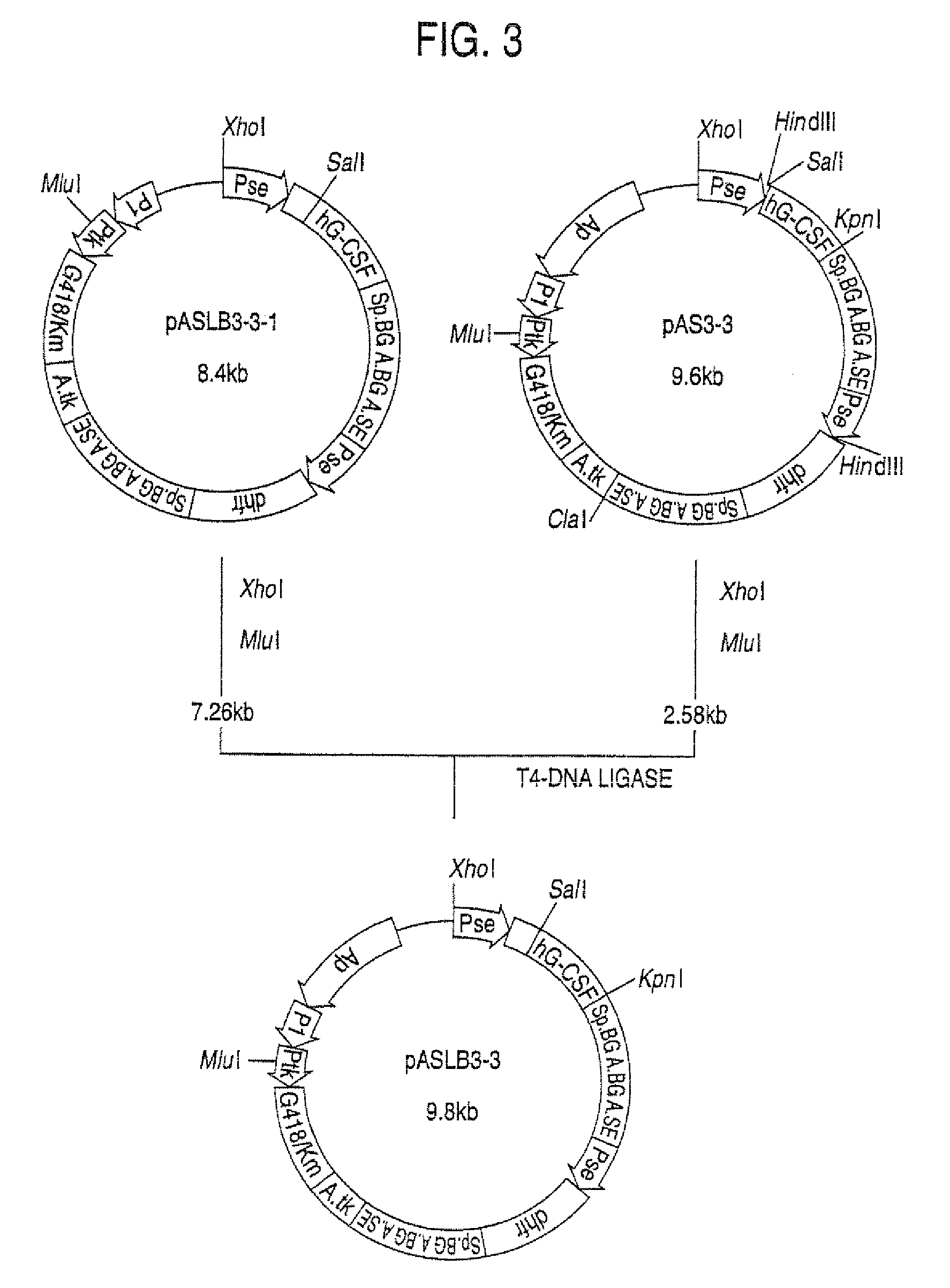Α-1,3-fucosyltransferase
a technology of -1,3-fucosyltransferase and -1,3-fucosyltransferase, which is applied in the field of new species of 1, 3-fucosyltransferase, can solve the problem of no means available for producing glycosyltransferases for use in synthesizing carbohydrate chains
- Summary
- Abstract
- Description
- Claims
- Application Information
AI Technical Summary
Benefits of technology
Problems solved by technology
Method used
Image
Examples
example 2
Synthesis of Sialyl Lewis x Carbohydrate Chain in KJM-1 Strain with Fucosyltransferase Expression Plasmid Introduced Therein
[0194]The plasmids pAMoPRC3Sc (direct expression cloning vector; control) and pAMoPRTH21 (fucosyltransferase expression plasmid) were prepared using Qiagen's plasmid preparation kit>plasmid6 cells, the cells were suspended in 8 ml of RPMI1640-ITPSGF medium and cultivated in a CO2 incubator at 37° C. for 24 hours. Then, G418 (Gibco) was added to a concentration of 0.5 mg / ml and cultivation was continued for 7 days. Thereafter, 22 ml of RPMI1640-ITPSGF medium (containing 0.5 mg / ml of G418) was added and cultivation was further conducted for 5 days. The thus-obtained transformants were cultured in RPMI1640-ITPSGF medium containing 0.5 mg / ml of G418. About 1×106 cells of each culture were placed in a microtube (1.5 ml; Eppendorf) and centrifuges (550×g, 7 minutes). The thus-collected cells were washed with 1 ml of phosphate-buffered saline (PBS) containing 0.1% sod...
example 3
Secretory Production of α-1,3-fucosyltransferase (TH21) in KJM-1 Cells
1. Construction of Secretory Expression Vector pAMoPRSA
(1) Construction of pAGE147 (cf. FIG. 18)
[0197]A plasmid, pAGE147, was constructed in the manner described below by replacing the SV40 early gene promoter of pAGE107 with the LTR promoter of the Moloney murine leukemia virus.
[0198]The plasmid pPMOL1 (JP-A-1-63394; 2 μg) was dissolved in 30 μl of Y-0 buffer, 20 units of SmaI was added and the digestion reaction was carried out at 30° C. for 3 hours. Then, NaCl was added to a concentration of 50 mM, 20 units of ClaI was added and the digestion reaction was carried out at 37° C. for 2 hours. The reaction mixture was subjected to agarose gel electrophoresis and a DNA fragment (about 0.6 kb) containing the LTR promoter of the Moloney murine leukemia virus was recovered.
[0199]Separately, 25 picomoles each of the two DNA linkers synthesized in Example 1, section 1-(8) were dissolved in 10 ml of T4 kinase buffer, 5 un...
example 4
Quantitation of α-1,3-fucosyltransferase (TH21) Transcription Product by PCR and Study of Expression Levels in Various Cells
[0303]The α-1,3-fucosyltransferase (TH21) transcription product was quantitated by quantitative PCR in the conventional manner [Gilliland et al.: Proceedings of the National Academy of Sciences of the U.S.A., 87, 2725 (1990)]. The β-actin transcription product, which is considered to be expressed at approximately the same level in all cells, was simultaneously quantitated to correct differences in the quantity of mRNA among cells and differences in the efficiency of conversion, due to reverse transcriptase, from mRNA to single-stranded cDNA among samples. Thus, the quantity of α-1,3-fucosyltransferase (TH21) transcription product for each cell species or cell line was expressed as a relative value with the quantity of β-actin transcription product being taken as 100.
[0304]The β-actin cDNA was prepared by PCR using, as a template, sing...
PUM
 Login to View More
Login to View More Abstract
Description
Claims
Application Information
 Login to View More
Login to View More - R&D
- Intellectual Property
- Life Sciences
- Materials
- Tech Scout
- Unparalleled Data Quality
- Higher Quality Content
- 60% Fewer Hallucinations
Browse by: Latest US Patents, China's latest patents, Technical Efficacy Thesaurus, Application Domain, Technology Topic, Popular Technical Reports.
© 2025 PatSnap. All rights reserved.Legal|Privacy policy|Modern Slavery Act Transparency Statement|Sitemap|About US| Contact US: help@patsnap.com



